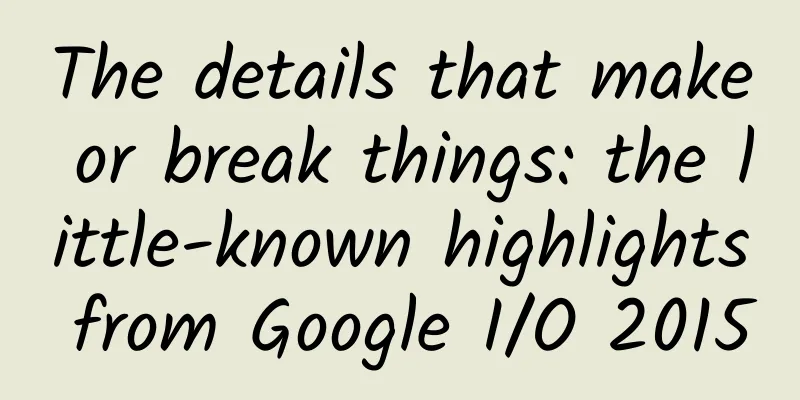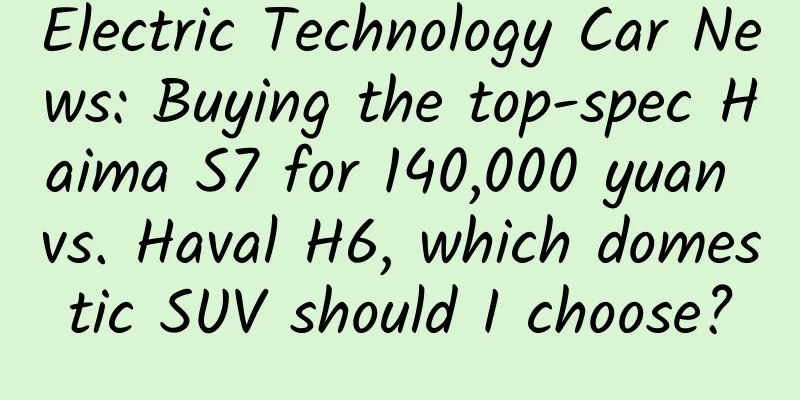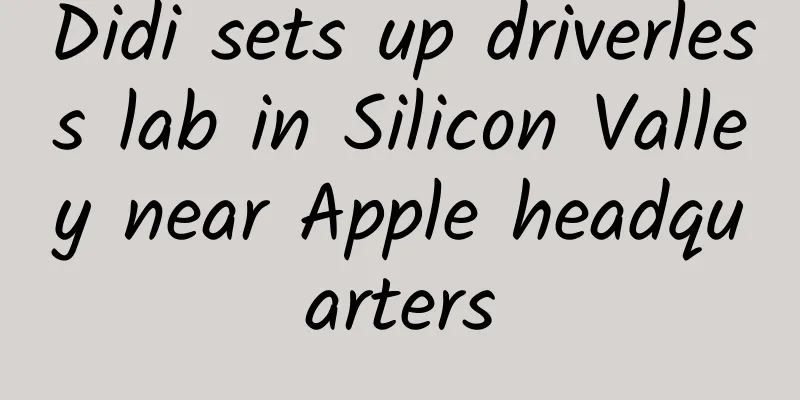The details that make or break things: the little-known highlights from Google I/O 2015

|
Google I/O 2015 will be held at Moscone Center West in San Francisco at 0:30 am on May 29th, Beijing time. A series of unexpected products such as the new generation operating system Android M and new Nexus devices may be unveiled there.
51CTO was the only Chinese technology community invited to participate. This morning, 51CTO reporters sent back reports from the Moscone Center West conference in San Francisco. While the 51CTO website was live-broadcasting the event, we also compiled some little-known details and highlights of the nearly three-hour I/O conference. 1. Android M
As a developer preview version of Android M, no one knows what kind of dessert M stands for. As a mobile operating system, Android M is an important part of this conference. For Android M, Google pays more attention to the quality, and the core is to improve the user experience. Engineers have solved many bugs and improved the overall quality of this open platform. They have improved the Android system in six areas, including development difficulty, the relationship between web pages and Apps, and payment and charging. 2. Android Wear
The new version supports a range of novel gesture controls, as well as a variety of sensors including Bluetooth, microphone, barometer, and more. Google disclosed that there are more than 4,000 applications available on the Android Wear platform. Of course, Google executives also took the opportunity to mock the Apple Watch, saying that the latter must make corresponding gestures to display the screen. 3. Brillo: IoT system platform Google launched the Brillo system with Android as the core. Brillo is an IoT platform. Brillo is based on Android, so it will be very convenient to pair and set up devices, which means that any Android device can easily connect to and control Brillo smart devices. In addition to Brillo, Google also released the Weave cross-platform protocol, which can connect the cloud, mobile phones and Brillo-supported devices, such as the thermostat of Nest, which was acquired by Google. Brillo will be available in the third quarter of this year, when IoT devices will be able to communicate with mobile phones and the cloud, and all devices will be able to use a unified language.
4. Android Pay: Payment system This is Google's own mobile payment solution. Android Pay is an open platform that supports devices with Android 4.4 or later. Google will build its own official fingerprint recognition support in the latest Android M. Last year, Apple also launched its own mobile payment service, Apple Pay, which can only be used on its own iPhone 6/6 Plus. For Google, the problem with Android Pay may not be that its competitors launched it first, but its own fragmented ecosystem: Samsung has its own payment service, but it also uses the Android system. How to balance the manufacturer and its own "small ecosystem" with Google's own large ecosystem may be an important issue. 5. Google Photos will support unlimited storage and automatic classification Google has released a new photo management app, Google Photos. This app gives users unlimited free cloud storage for pictures and videos, can automatically synchronize photos on all devices, and can be managed with gestures on mobile phones and other devices, such as pinch-to-zoom to switch timelines and view photos, which basically makes Google Photos more Apple-like. However, it still has something worth talking about: Google Photos combines Google's recognition technology to automatically identify people or different events in photos, and can automatically add notes for users without manual work. That is to say, when managing pictures, it can automatically recognize the face of one of your friends, and thus classify all photos containing him together. Of course, when you search for skiing in Crater Lake, all photos related to skiing will also be gathered together. According to the speaker, this app will be launched later today, and Pingwest will also release relevant reviews to let you know about this app as soon as possible.
6. New development tools and cloud testing tools The preview version of Android Studio 1.3 improves the accuracy and performance of Gradle compared to the previous version. The new CPU and memory profiles make it perfect for C++. Google provides Cloud Test Lab service, which will appear in the interface of Google's console. This greatly solves the problem of inconsistent specifications of various Android phones and the difficulty of testing. The latter is a problem that has troubled Android developers for many years. Of course, we understand that there is a difference between cloud testing and real device testing. At least, it avoids the situation where developers have to find (or buy...) many kinds of mobile phones to test their applications. Firebase has supported nearly 200,000 apps in the backend. The computing, data, storage and other services it provides all rely on Google Cloud Platform. The most important thing is: Google SDK as Cocoapods: SDK that provides Google services for iOS platform. (iOS compatibility was mentioned countless times during the press conference) The latter is a problem that has troubled Android developers for many years. Of course, we understand that there is a difference between cloud testing and real device testing. At least, it avoids the situation where developers have to find (or buy...) many kinds of mobile phones to test their applications. 7. Google Play Homepage: Improving Revenue For a long time, the pain point of Google App Store has been that its revenue is not as high as that of iOS platform. Now, (perhaps to emphasize) the role of developers, they have their own homepage on Google Play Store! Google is also trying to improve developers' revenue situation. They can now create their own homepages on the Google Play app store. In addition, the new advertising system Admob supports 40 advertising networks, making it easier for developers to make money. This is real motivation for building an ecosystem. 8. Google Now: Improved experience Google Now has become very smart through years of learning from user behavior. Google Now will be able to answer more questions and more accurately. Its new "now on tap" feature is even more thoughtful. In a specific application, long press the home button to turn on Google Now, and it will provide you with the information you need most on the current interface. For example, when your friend asks you on WeChat if you want to watch "Big Hero 6", Google Now will use this as a basis to provide you with various useful information about the movie, such as its rating, etc. In addition, at the conference, the speaker showed some other practical application scenarios. For example, Google Now can show users the location of the nearest gas station in front of them when they are driving; it can automatically identify the song name and singer when playing a song; it can remind you of unfinished things during the text message process (for example, if your family sends you a message saying "Don't forget to buy apples", Google Now will not only remind you to buy apples, but also give you the nearest apple store and the route to get there).
9. Cardboard Expedition The Cardboard VR glasses, which looks like a child's toy, contain a lofty ideal. It is the only thing related to hardware tonight. Cardboard has more than 1 million users around the world. This low-cost VR technology can help you go anywhere. The Expedition project is a good example of Cardboard application. Teachers can take students to any place they want to go in class, and even take students to experience the underwater world. This brings a new teaching experience to the education industry. Moreover, its cost is very low, much lower than the iPad teaching advocated by Apple. 10. Self-driving cars This is a project that Google has been working on for many years, and Google has announced its new progress. In the United States, autonomous driving technology has been developed in cooperation with many manufacturers. Google's own prototype autonomous car has safely traveled more than 1 million miles. Through computer calculations, we can identify surrounding vehicles and pedestrians and plan a safe driving path. Google I/O is an annual conference for web developers held by Google. The focus of the discussion is on developing web applications using Google and open web technologies. Android system and Google Glass were both released at this conference. 11. Google Maps will support offline navigation Google today made another big move in its map function. In order to cater to the needs of developing countries with relatively scarce network resources, Google Maps will support offline navigation. At the same time, the map can support users to view the business hours and reviews of attractions and restaurants offline. summary Sundar Pichai, Google's head of products, finally took the stage and concluded: "All technology is designed to solve problems for users and for everyone in the world." In my opinion, this press conference was full of highlights but lacked a climax. Google has always wanted to change the world and is working hard to do so. |
<<: 51CTO Video APP Android version released, millions of gifts are given away! ...
>>: Cocos training stationed in Ledong Excellence to teach and inspire the scene
Recommend
What will the weather be like tomorrow? AI predicts
The Earth we live on is experiencing one of the h...
The entire province of Hubei recognizes health codes from other provinces, and no one may request additional certificates!
China News Service, March 19. According to the we...
World Quantum Day | Why is it so elusive to scientists? Unveiling the mystery of quantum
|||| Compiled by New Media Editor Duan Dawei Apri...
Is the "Hellhound" variant "killing people like crazy" in Japan? Here's the truth!
Since the global outbreak of the COVID-19 pandemi...
7 ways to effectively achieve user retention!
User retention is the lifeline for most products ...
Integrated Marketing, what is “integration”?
When we talk about integrated marketing , we are ...
Deloitte Consulting: 2025 China Life Sciences and Healthcare Industry Research Report
The survey covers multiple areas, including busin...
US judge: WeChat ban violates user rights and will not be allowed to be enforced
After a U.S. district court urgently halted the U...
APP Promotion: How to write an email to apply for App Store Featured Recommendation (Example)
If an App can be selected as a "Featured Rec...
Tips for choosing advertising channels!
As of today in 2020, with the rapid rise and matu...
I gained 180,000 followers in 3 days. How did I plan the free giveaway?
Editor's note: When running an event , giving...
How to buy traffic and acquire users on Douyin at low cost?
Tik Tok is still in its wild growth period, with ...
Dalian home improvement mini program agent price inquiry, how much is the Dalian home improvement mini program agent price?
What is the price of Dalian home improvement mini...
Ten thousand words long article: Detailed explanation of the 10 major formulas for trading communities
Community operation is an important means to main...
Cocos Developer Salon——Cocos Studio V2.1 Open Plan
In the era of mobile Internet, the mobile game in...









